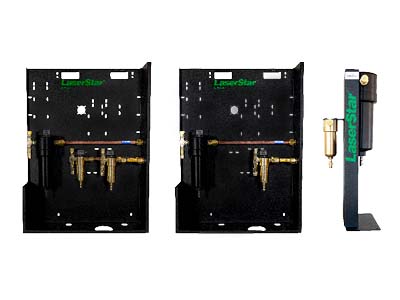Extend Window Life and Protect Cut Consistency
The rapidly growing technology of laser cutting is dominated by two main methods -- carbon dioxide (CO2) laser cutting and fiber laser cutting. Both processes offer increased precision and versatility for over plasma cutting and other methods, and the technology is continually evolving toward improved precision, ease-of-use and flexibility.
As suggested in one of our earlier articles, fiber lasers are considered more advantageous, particularly in beam delivery and energy efficiency. A fiber cutting system is primarily suited for processing thin to thick sheet metal including steel, stainless steel, aluminum, as well as other non-ferrous metals like copper and brass.

"As a fiber laser's power increases, so does the potential of beam refracting or energy scattering due to particles," says Larry Cherne, market manager for Praxair's laser gases.
Particles, such as common dust, metallic dust or flakes are generally smaller than 40 micron, or invisible to the unaided human eye but can scatter or deflect the beam energy away from the target.
"This is not typically an issue with the 2 or 3 kw fiber lasers, but it can become a more noticeable issue as power increases," says Cherne.
Not only does the beam shape change, but energy can be reflected back to the head causing head overheating. Because reflected energy needs somewhere to go, the likelihood of hitting the cutting target is reduced, making it more difficult to create accurate and assemblies and causing finished cuts to look rougher. This leads to an increase in scrap metal, window spatter and operation costs and a decrease in travel speeds.
LaserStar™ Filter Panels
Praxair's LaserStar™ filter panel is designed to trap sub-micron particles to help extend the life of your windows, while minimizing pressure drop and maintaining gas pressure and flow needed for precision laser cutting.
If the gas supply system has other known contaminates, like THC or water, then the panel can be modified to handle them. Contaminates can be caused by various scenarios:
- An installer may have obtained copper that has not been washed, capped and cleaned for O2 service.
- The installer may have used a flux when it is not required on copper to copper joints.
- Oil may have been used to cut a stainless steel thread.
With Praxair's LaserStar regulator/filter and filter panels, good filtration can be beneficially applied to the fiber laser's incoming gases to help keep the fiber laser at peak performance and reduce operating costs.
LaserStar Regulators
Praxair's LaserStar filter panels can include regulators that provide precise pressure control or management before the gases enter the laser. LaserStar K-12 regulator is a new design that is required by the fiber laser for greater flow rates. The ¾ inch inlet/outlet fittings double the flowrates available to the laser cutting process. This is important Fiber laser power increases and flowrates also increase.
In Conclusion
The removal of particles helps improve laser cut quality and speed, while reducing time wasted replacing windows, overheated heads, dross formation, rough cuts and through slower cutting speeds. Contact your local Praxair representative today or call us at 1-800 225-8247 to find out how our experts can help you protect your laser cutting productivity with LaserStar.




























